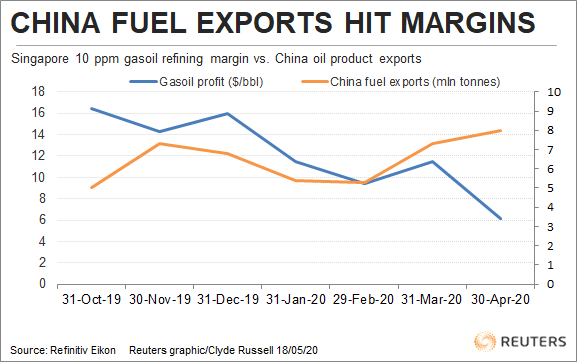According to a Reuters report written by Clyde Russell, the rebound in China’s crude oil processing in April looms large over Asia’s refineries, which are already battling weak profit margins from the slump in fuel demand caused by lockdowns aimed at containing the coronavirus pandemic.
A Recovery In Fuel Demand
- China’s refineries processed the equivalent of 13.1 million barrels per day (bpd) in April, up from a 15-month low of 11.78 million bpd in March, according to calculations based on official data released on May 15.
- While the higher processing rate reflects a recovery in fuel demand in China after it lifted most lockdown restrictions, it also raises the likelihood that more refined products will be exported into a well-supplied Asian market.
- There are already signs that China’s modern, low-cost refineries are playing a bigger role in Asia’s refined product markets, with official data showing fuel exports at a record-high 8 million tonnes in April, up 10.2% from March and 29.7% from the same month in 2019.
- While a full breakdown by fuel type isn’t yet available, using a conversion factor of eight barrels of product per tonne gives a fuel-export figure of 2.13 million bpd.
- For the first four months of the year, China exported 1.72 million bpd of refined products, up 15.1% from the same period in 2019.
Increased Chinese Fuel Exports Weakening Asia
The increase in fuel exports from China isn’t the sole reason for the regional weakness in refinery profit margins, but it certainly is a contributing factor, and appears to be largely structural rather than a temporary phenomenon.
China issued a second batch of fuel export quotas for this year to domestic refiners, allowing for 28 million tonnes of shipments, mainly for gasoline, diesel and jet kerosene, Reuters reported on May 11, citing four sources.
This follows the first 2020 allowance of 27.99 million tonnes and means Chinese refiners can keep product exports at the current high levels, should they so choose.
MARGINS SUFFERING
- There are various methods of calculating refinery margins, with one of the benchmarks being the profit per barrel at a typical Singapore refinery using Dubai crude <REF/MARGIN1>.
- This was showing a loss of $3.29 a barrel in early trade on Monday, wider than the five-day average of a loss of $1.84 and well below the moving 365-day average of a profit of $2.57.
- The main culprit is gasoline, for which demand has been severely affected as a result of personal transport being curtailed by the lockdowns in various Asian countries.
- The cost of producing 92-RON gasoline in Singapore from Brent crude was a loss of 85 U.S. cents per barrel on May 15.
While this was up from a record low of a loss of $13.15 a barrel on April 14, it’s still well short of the high so far this year of a profit of $9.35 on Feb. 11, just as the coronavirus was breaking out of China to spread around the globe.
The margin for gasoil, the building block of diesel and jet kerosene, has held up better, ending at a profit of $3.45 a barrel on May 15, but this was just over a quarter of the $12.79 high so far this year, reached on March 30.
Diesel demand has held up relatively well during the coronavirus crisis as freight, heavy vehicle transport, agriculture and mining have all largely continued.
Idling Capacity Saving Margins from Falling?

Another factor that has perhaps prevented refining margins from falling more than they already have was the idling of capacity during recent weeks, with Refinitiv Oil Research data showing a sharp drop in utilisation.
Putting together the four biggest refining nations in Asia – China, India, Japan and South Korea – shows runs were just 84% of capacity in April, down from the annual averages of 94%-97% over the previous five years.
Refinery throughput is likely to increase in coming months, though, as more plants come back on stream as lockdowns are lifted. The question is whether the nascent recovery in fuel demand will be more, or less, than the additional volume of products being produced.
Did you subscribe to our daily newsletter?
It’s Free! Click here to Subscribe!
Source: Reuters
















